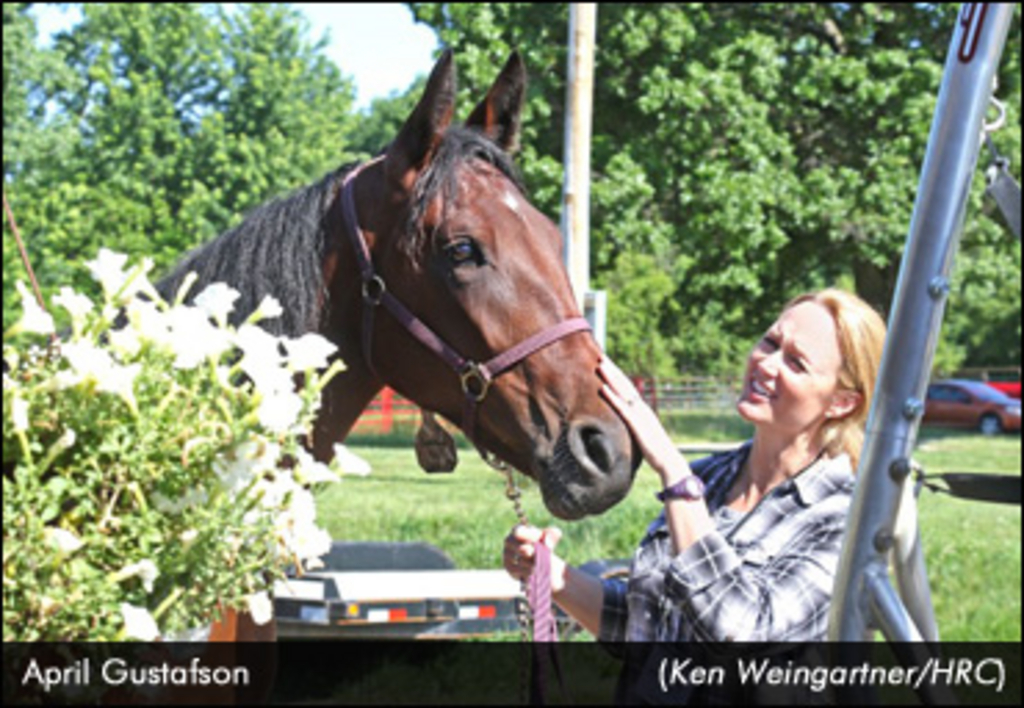
After moving to Kentucky from Texas, April Gustafson saw her Amish neighbours driving around with horses she didn’t recognize. The horses were Standardbreds and Gustafson, who showed horses 20 years ago, was intrigued. After convincing her neighbours to give her a ride, and later to let her jog some of the horses, she was hooked.
Gustafson, who is a logistics officer fulltime in the U.S. Army Reserve at Fort Knox, and her husband bought shares of a half dozen racehorses last year. Now Gustafson, after saving up enough leave, is at the U.S. Trotting Association’s Driving School to continue learning about the breed and racing.
“We just went out on a limb and went into some partnerships with some people and I can’t tell you how much fun we’ve had,” Gustafson said. “I think once horses are in your blood they’re always in your blood, even if you’ve been away from them for a little bit. I’m just thrilled to be here. I want to learn as much as I can.”
The USTA Driving School, which runs through Saturday at the Delaware County Fairgrounds in central Ohio, offers participants a mix of hands-on learning and classroom sessions culminating with the administration of the USTA trainer and/or driver exam.
Thursday’s schedule featured morning barn work and jogging horses followed by classroom sessions with driver Peter Wrenn as well as trainers Ron Potter and Mike Conklin. There also was discussion of stable management with Jennifer Brown and horse ownership and amateur racing with Steve Oldford, Gregg Keidel, and Mike Mitchell.
Gustafson spent the morning working in the stable of trainer Brian Brown. The highlight of the morning was getting to jog horses on the famed half-mile track at the fairgrounds, which is the home of the Little Brown Jug.
“People dream of getting to do that, and we did,” Gustafson said. “It’s pretty awesome. I think it might be fun to drive someday at some fairs or something like that.
“It’s just great how welcoming and nice everyone is,” she added.
There was only one drawback to how much Gustafson enjoyed her day with the horses.
“My job is a lot of fun, but not as much fun as this,” she said, adding with a laugh, “I might not want to go back.”
Scott Hancock, an IT tech assistant from Indiana, could understand how Gustafson felt.
“I wish this was around when I was younger,” the 47-year-old Hancock said. “If I was 21 right now I probably wouldn’t go home. I’d start looking for a job right now.”
Hancock, who was attending the school with his friend, Vince Koser, has been a fan of harness racing for a number of years, but had no family or other connection to the sport.
“I’ve always seen in the program owners from around where I live and was always curious about how to break in,” Hancock said. “It’s just something I always wanted to do, but didn’t know anyone. I don’t think I’m going to have a career in it now, but I’d be interested in amateur driving or helping out part time at a barn. I have some friends and we might go together and buy a horse. But there’s still a lot to learn.”
Hancock was among 13 of the 20 participants at the school who never jogged a horse until Thursday.
“It was exciting,” he said. “It was everything I hoped.”
He also was happy working with the horses in the stable.
“Cleaning the stalls, that’s part of it,” Hancock said. “Just to give them a bath, brush them; it was something new and something I’ve always wanted to do. I enjoyed every part of it. It was all good.”
Koser, an IT manager, said it was interesting to see the work that goes on behind the scenes with racehorses.
“You know this stuff goes on, but it’s been neat to be with a groom and go through the process of getting them out, bathing, changing the stalls over, feeding,” Koser said. “It’s really neat to learn. It’s a lot of organization for the number of horses here.”
Koser also sat behind a horse for the first time.
“It was really fun,” he said. “It’s hard for me to imagine what it would be like at full speed instead of a jog. I hope that tomorrow I can go a couple more times. I was surprised how responsive the horse is to what you’re doing. It wasn’t as tough as I thought it would be. I’m sure it’s a lot harder when everybody is packed in going five times as fast, but I felt in more control than I thought I would be.”
A longtime fan of harness racing, Koser might also pursue horse ownership in the future.
“I didn’t come here with any aspirations,” Koser said. “I think maybe doing a partnership for a small piece of a horse to stay involved and continue learning about it would be interesting to me. I’ve enjoyed this a lot.”
Friday’s schedule includes barn work and sessions on amateur driving clubs, horse nutrition and horse ownership followed by a trip to Scioto Downs.
This story courtesy of Harness Racing Communications, a division of the U.S. Trotting Association. For more information, visit www.ustrotting.com.

